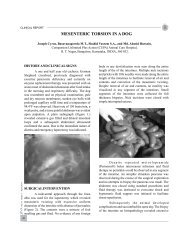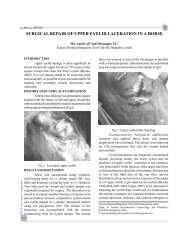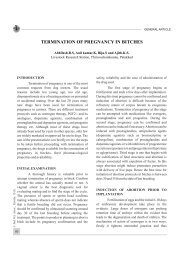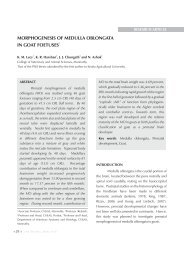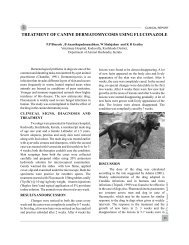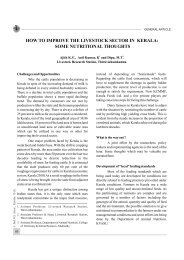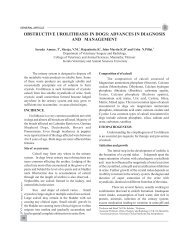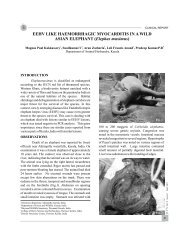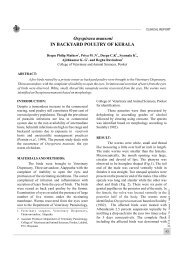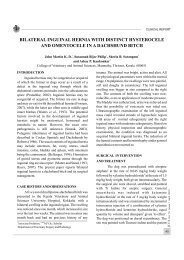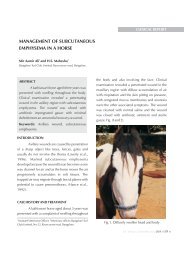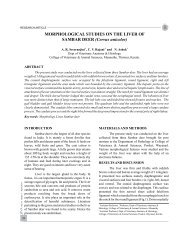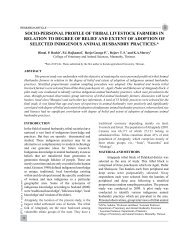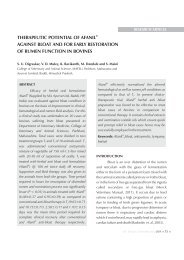6than 10 colony forming unit / gram of intestinalcontent which is much higher than the normal value(Regan, 1977). So to avoid these, oral antibiotics likeMetronidazole at dose rate of 7.5-15 mg/kg BWtwice daily or Tylosin at a dose rate of 20-30 mg/kgBW / day for 6 week were advocated. Fresh rawpancreas of beef can be advisable for animals whichare suffering from exocrine pancreatic insufficiency.Porcine pancreas is not preferable because there is achance of Aujezk's disease. (Khan et al 2005).Confirmatory test for the exocrine pancreaticinsufficiency is estimation of the serum trypsin likeimmunoreactive (TLI) protein. In normal range forthe TLI are 5- 32 micro g / L. If the concentration isless than 2 micro g/ L, it is considered as the animal issuffering from the exocrine pancreatic insufficiency(Westermarck, 2003). In most of the case animalneed a lifelong treatment.CLINICAL REPORTREFERRENCE:Khan, C.M 2005: the Merck Veterinary Manual,ninth edn, Merks & Co., INC, Whitehousestation, U.S. 2712ppNelson, R.W., Couto, C.G. 2003: Small InternalMedicine, Third edn, Mosby, Missouri,U.S. 1362ppWestermarck, E., Wiberg, M. 2003: Exocrinepancreatic insufficiency in dogs, Vet ClinNorth Am Small Anim Pract. 33: 1165-1179ppRegan, P.T., Malagelada, J.R., Dimango, E.P.,Glanzman S.L., and Vay, L.W. 1977:Comparative Effect of Antacids,Cimetidine and Enteric Coating on theTherapeutic Response to Oral Enzyme InSevere Pancreatic Insufficiency. N Engl JMed. 297: 854-858ppINDEXING AND ARCHIVING IN CAB ABSTRACTS -JOURNAL OF INDIAN VETERINARY ASSOCIATION, KERALAFrom : Uma Sabapathy Allen Subject : Indexing and archiving in CAB Abstracts - Journal of Indian Veterinary Association, KeralaTo : "vijikumaran@yahoo.com" Date : Tuesday, 28 February, <strong>2012</strong>, 21:34Dr. K.Vijaya KumarChief Editor, Journal of Indian Veterinary Association, Kerala (ISSN 0975-5195)I am writing on behalf of CAB International regarding the Journal of Indian Veterinary Association, Kerala.We recently evaluated the journal according to our internal selection criteria of potential yield, scientific valueand geographic origin and judged its content to be both novel and important, and deemed to be very relevant to the CABAbstracts database produced by CABI.We would therefore like to request permission not just to abstract and index the title but also to archive thejournal's full-text content in the CABI Full-Text Repository. For the latter we would only require non-exclusive inter<strong>net</strong>publishing rights; copyright remains with the publisher/author, allowing them to publish the material through anyinter<strong>net</strong> site/publication.I understand the JIVA is an open access publication. By including the JIVA and as many publications aspossible in the full-text repository, we hope to ensure that they are preserved and easily located by researchers andprofessionals throughout the world, both now and in the future. This would also be a valuable way of promoting thepublications amongst the global users of CAB Abstracts. A list of documents currently available in the repository can beviewed at http://www.cabi.org/fulltextPlease let me know if you require further information to support this request.Uma AllenContent Editor, CABI Head Office, Nosworthy Way,Wallingford, Oxfordshire, OX10 8DE, United KingdomTelephone: +44 (0)1491 829458, Fax: +44 (0)1491 833508Email: u.allen@cabi.org Visit us at: www.cabi.orgThank you.Uma AllenJIVA Vol. 10 Issue 1 <strong>April</strong> <strong>2012</strong>55
GENERAL ARTICLEMETHANE EMISSION FROM RUMINANTSENVIRONMENTAL IMPLICATIONS AND STRATEGIESFOR REDUCTION.Lalu. K., Usha. A.P., Venkatachalapathy.R.T and Prasanth.V.Centre for Pig Production and Research, MannuthyINTRODUCTIONMethane, the simplest aliphatichydrocarbon, is one of the gaseous end products offermentative digestion in ruminants. It is releasedinto the atmosphere by eructation. It is twenty timesmore potent than carbon dioxide as green house gas.Its atmospheric concentration has doubled sinceindustrial revolution. About 22 Percent ofanthropogenic methane is from ruminants.Continuous release of methane is a matter of worry. Italso contributes to green house effect by the processcalled radiative forcing leading to global warmingwhich in turn result in erratic weather patterns,desertification and rising of sea level due to meltingof polar ice cap.METHANE PRODUCTION BY INDIANLIVESTOCKIndian livestock contribute about 14 Percentof total methane emitted by world livestock.According to Khan et al., (1996) methane productionper head of animal (cattle/buffalo) is only 170liters/day which is much less than in the developedcountries where animals are managed in factorystyle. Comparative emission of methane fromanimals is presented in Table 1. The energy content ofmethane is very high (13.25 Kcal/g) and the amountof methane belched by Indian cattle is equivalent tothe feed costing to Rs 2.7 crores per day.J. Ind. Vet. Assoc., Kerala. 10 (1)ENVIRONMENTAL HAZARDS DUE TOMETHANEAmong the entire green house gasesmethane is one of the most dangerous as its radiativeforcing effect is very high that the greenhousepotential of one unit of methane is expressed as 7.5 Cequivalent. Moreover the rate of production ofmethane is higher when compared to any other greenhouse gases. Methane has both direct and indirecteffect on climate. It interacts directly with chlorine inpresence of infrared energy in the upper troposphere56



